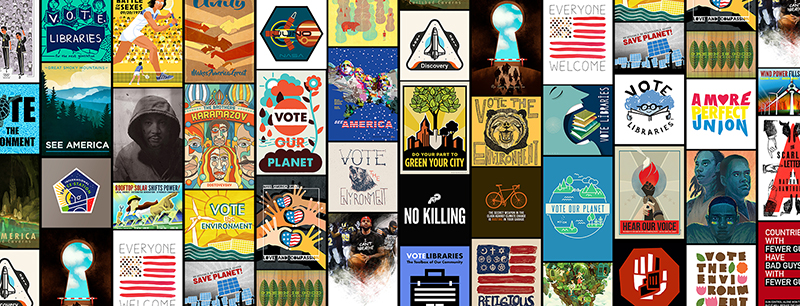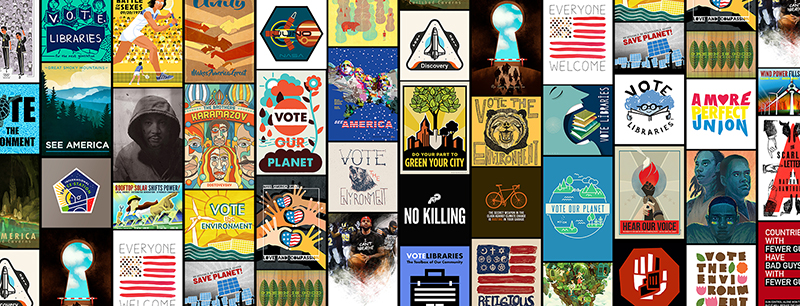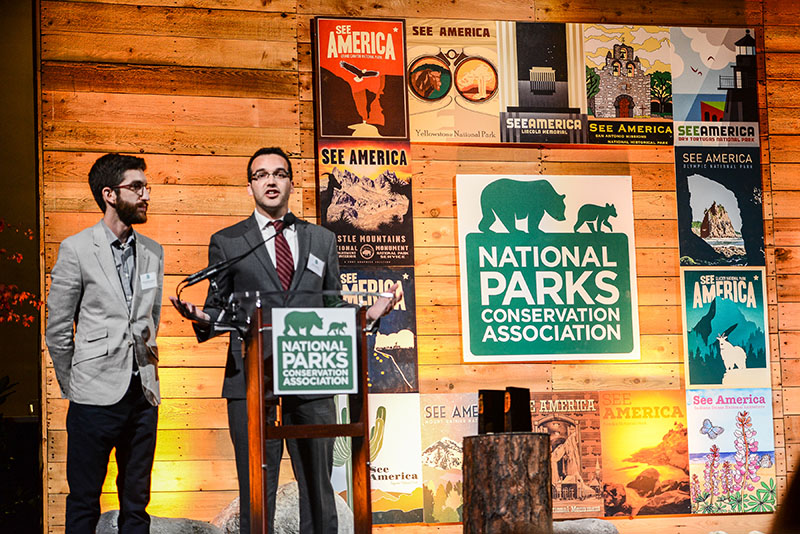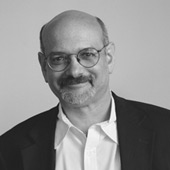
August 16, 2018
Creative Action Network: Profiting From A Nonprofit

A CAN Poster, “Hear Our Voice” by Liza Donovan, at the Women’s March in Los Angeles.
They strive to be a modern day WPA (President Franklin Delano Roosevelt’s Depression-era job creation program that enlisted artists of all kinds for the common good). They are the Creative Action Network (CAN), a community of artists, designers and activist that create “art with purpose.” Their goal is to profit for good in a nonprofit environment. In the Summer of 2008, Aaron Perry-Zucker, then a senior at RISD, inspired by Shepard Fairey’s “Hope” poster, launched designforobama.org, where anyone could upload a poster of support. Later with Max Slavkin they founded CAN, which has run crowdsourced campaigns around significant causes, inviting everyone to contribute their own designs. In an entrepreneurial spirit, the designs are made into a range of physical goods, from posters to apparel to home goods, which are sold online, and through retailers all over the country, supporting artists and causes with every purchase.
In Spring 2016, however, CAN was at the inevitable sustainability crossroads where many social nonprofit groups get stuck. After nearly four years of steady growth, three big retail deals fell through, all in the same week. “Looking back,” Slavkin told me, “we’re glad it happened, in that it forced us to revisit our long term plan, and evaluate whether brick & mortar retail would be our future.” Slavkin and Perry-Zucker knew they needed to ramp up their e-commerce efforts, but without the capital for the kind of web upgrades and paid acquisition they needed survival options. “That’s when we decided to try raising capital for the first time,” Slavkin says, “and just about exactly a year later, we did it!”

A sampling of CAN art from across our different campaigns
The challenge, however, was that they had to deal with venture capitalists (VCs), which could easily turn into a classic Faustian bargain as was illustrated by an early encounter: About year ago when, after launching a successful anti-gun campaign, Slavkin was meeting with a VC, who suggested that by crowdsourcing art about “the other side” of issues like gun control, they could sell twice as many. “I don’t hold it against them personally . . . I think it’s much more an indictment of the core financing models we’re used to more than any individual.” For most investors in most businesses most of the time, causes or political issues are just not a part of the calculation. Investors see a business like CAN as limiting because it picks values that do not optimize for profit.

Surprisingly, being based in San Francisco also added a layer of difficulty. “Being in San Francisco leaves one with the impression that raising VC money is the only way to grow a business,” recalls Slavkin, “and for years, that’s what we thought too. But we’re proud that we did not raise money from VCs, and instead built a new, alternative, mission driven model. (Slavkin writes in detail about the alternative here.)
Taking VC money means implicitly that the investment must be satisfied. So how raising capital with a program focusing on protest and advocacy is something of a quandary. While they did not take VC investment, they did take investment, “and in our model, that means we need to pay our investors back 5x of their investment over time,” Slavking explains. “So while we don’t need to have IPO-level profits, we do very much still need to grow and make a profit. We do that by selling our advocacy artwork on posters, t-shirts, and other physical goods on our own website, and in retailers nationwide.”

Pop-Up Gallery Show at New York Public Library featuring CAN’s Recovering The Classics campaign — crowdsourcing original covers for classic books.
Who could have anticipated this much business acumen would be necessary to support an advocacy organization? Perry-Zucker’s background is in graphic design and Slavkin’s is in political science — neither of them had any real business experience before starting CAN. They are grateful for the experience they had in Matter.vc’s accelerator program back in 2013, where they learned a lot about the nuts & bolts of business. “They really helped us transform our art project into a social impact business.”

Aaron Perry-Zucker (left) and Max Slavkin (right) accept National Parks Conservation Association’s Robin. W. Winks Award For Enhancing Public Understanding Of Our National Parks. Washington, DC., May 5, 2016
CAN’s mission is putting artists to work telling stories that matter. Their goal is to build a lasting cultural institution that inspires action while supporting artists & nonprofits. Similar to brands like Patagonia or TOMs or Warby Parker, “we want to be a destination for consumers who want to express their values with their dollars. We want to be a modern-day WPA.”

Observed
View all
Observed
By Steven Heller
Related Posts

Business
Courtney L. McCluney, PhD|Essays
Rest as reparations: reimagining how we invest in Black women entrepreneurs

Design Impact
Seher Anand|Essays
Food branding without borders: chai, culture, and the politics of packaging

Graphic Design
Sarah Gephart|Essays
A new alphabet for a shared lived experience

Arts + Culture
Nila Rezaei|Essays
“Dear mother, I made us a seat”: a Mother’s Day tribute to the women of Iran
Recent Posts
Candace Parker & Michael C. Bush on Purpose, Leadership and Meeting the MomentCourtney L. McCluney, PhD|Essays
Rest as reparations: reimagining how we invest in Black women entrepreneurs Food branding without borders: chai, culture, and the politics of packaging Why scaling back on equity is more than risky — it’s economically irresponsibleRelated Posts

Business
Courtney L. McCluney, PhD|Essays
Rest as reparations: reimagining how we invest in Black women entrepreneurs

Design Impact
Seher Anand|Essays
Food branding without borders: chai, culture, and the politics of packaging

Graphic Design
Sarah Gephart|Essays
A new alphabet for a shared lived experience

Arts + Culture
Nila Rezaei|Essays

 Steven Heller is the co-chair (with Lita Talarico) of the School of Visual Arts MFA Design / Designer as Author + Entrepreneur program and the SVA Masters Workshop in Rome. He writes the Visuals column for the New York Times Book Review,
Steven Heller is the co-chair (with Lita Talarico) of the School of Visual Arts MFA Design / Designer as Author + Entrepreneur program and the SVA Masters Workshop in Rome. He writes the Visuals column for the New York Times Book Review,